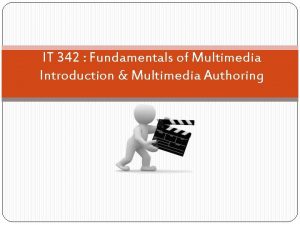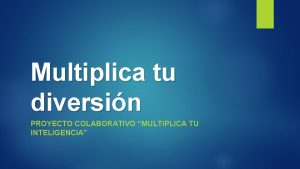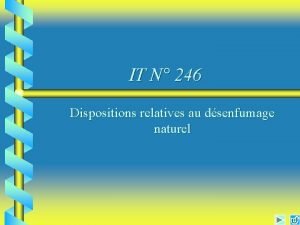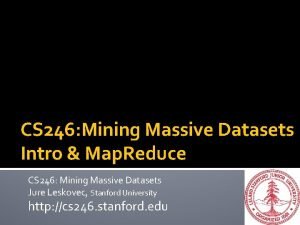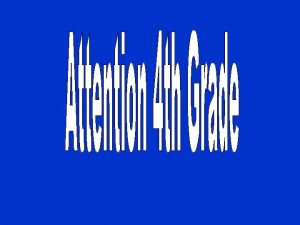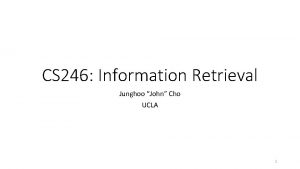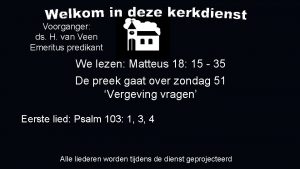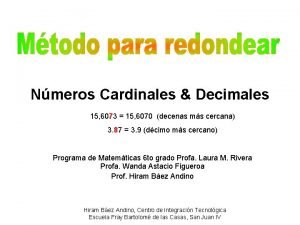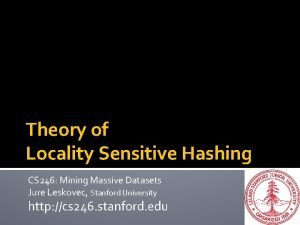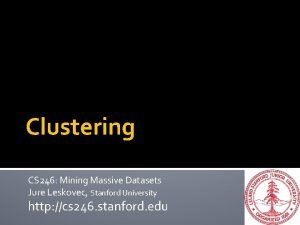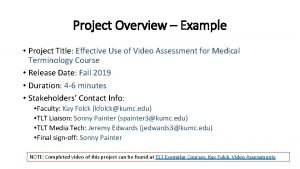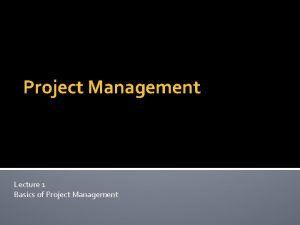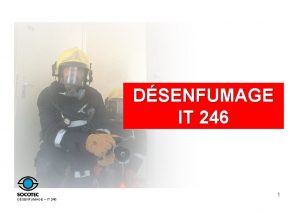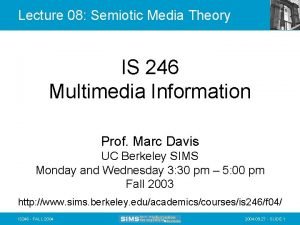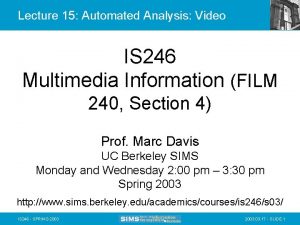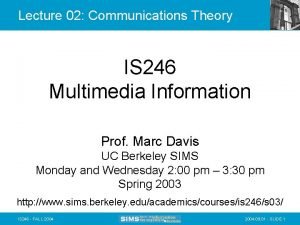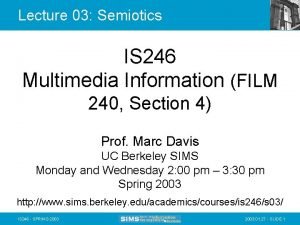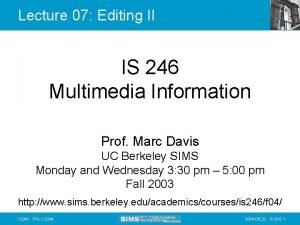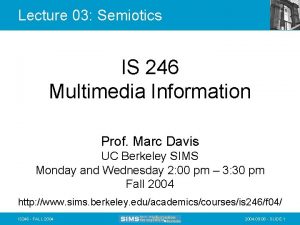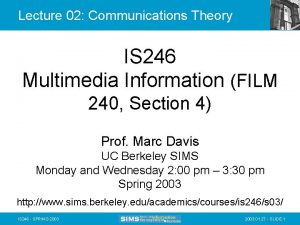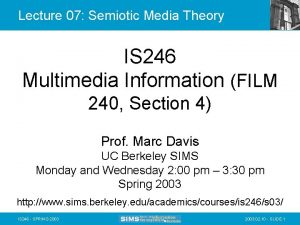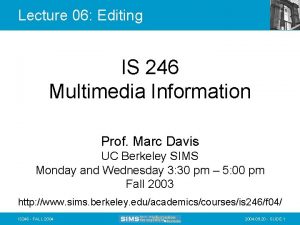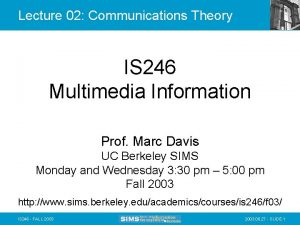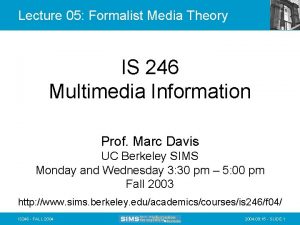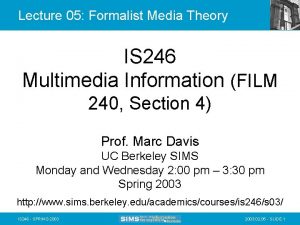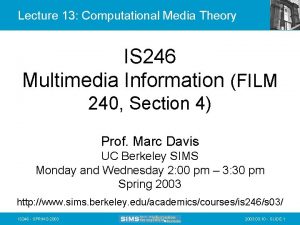Lecture 18 Final Project Overview IS 246 Multimedia

























- Slides: 25

Lecture 18: Final Project Overview IS 246 Multimedia Information (FILM 240, Section 4) Prof. Marc Davis UC Berkeley SIMS Monday and Wednesday 2: 00 pm – 3: 30 pm Spring 2003 http: //www. sims. berkeley. edu/academics/courses/is 246/s 03/ IS 246 - SPRING 2003. 04. 02 - SLIDE 1

Today’s Agenda • Review of Last Time • Final Project – Final Project Overview – Final Project Ideation – Final Project Team Building • Action Items for Next Time IS 246 - SPRING 2003. 04. 02 - SLIDE 2

Today’s Agenda • Review of Last Time • Final Project – Final Project Overview – Final Project Ideation – Final Project Team Building • Action Items for Next Time IS 246 - SPRING 2003. 04. 02 - SLIDE 3

What is the Problem? • Today people cannot easily find, edit, share, and reuse media • Computers don’t understand media content – Media is opaque and data rich – We lack structured representations • Without content representation (metadata), manipulating digital media will remain like wordprocessing with bitmaps IS 246 - SPRING 2003. 04. 02 - SLIDE 4

Desiderata for Media Metadata • At least, Pat should be able to use Pat’s metadata • Better, Chris should be able to use Pat’s metadata • Even better, Chris’s computer should be able to use Pat’s metadata • At best, Chris, Pat, and their computers should be able to use the metadata they all produce IS 246 - SPRING 2003. 04. 02 - SLIDE 5

Representing Video • Streams vs. Clips – Stream-based annotation makes annotation pay off • The richer the annotation, the more numerous the possible segmentations of the video stream • Clips change from being fixed segmentations of the video stream, to being the results of retrieval queries based on annotations of the video stream • Annotations create representations that make clips, not representations of clips • Video syntax and semantics – The Kuleshov Effect – Video has a dual semantics • Sequence-independent invariant semantics of shots • Sequence-dependent variable semantics of shots • Ontological issues in video representation – Video plays with rules for identity and continuity • • Space Time Person Action IS 246 - SPRING 2003. 04. 02 - SLIDE 6

The Search for Solutions • Current approaches to creating metadata don’t work – Signal-based analysis – Keywords – Natural language • Need standardized metadata framework – – Designed for video and rich media data Human and machine readable and writable Standardized and scaleable Integrated into media capture, archiving, editing, distribution, and reuse IS 246 - SPRING 2003. 04. 02 - SLIDE 7

Signal-Based Parsing • Effective and useful automatic parsing – Video • • Scene break detection Camera motion analysis Low level visual similarity Feature tracking – Audio • Pause detection • Audio pattern matching • Simple speech recognition IS 246 - SPRING 2003 • Approaches to automated parsing – At the point of capture, integrate the recording device, the environment, and agents in the environment into an interactive system – After capture, use “humanin-the-loop” algorithms to leverage human and machine intelligence 2003. 04. 02 - SLIDE 8

Why Keywords Don’t Work • Are not a semantic representation • Do not describe relations between descriptors • Do not describe temporal structure • Do not converge • Do not scale IS 246 - SPRING 2003. 04. 02 - SLIDE 9

Natural Language vs. Visual Language Jack, an adult male police officer, while walking to the left, starts waving with his left arm, and then has a puzzled look on his face as he turns his head to the right; he then drops his facial expression and stops turning his head, immediately looks up, and then stops looking up after he stops waving but before he stops walking. IS 246 - SPRING 2003. 04. 02 - SLIDE 10

Notation for Time-Based Media: Music IS 246 - SPRING 2003. 04. 02 - SLIDE 11

Visual Language Advantages • A language designed as an accurate and readable representation of time-based media – For video, especially important for actions, expressions, and spatial relations • Enables Gestalt view and quick recognition of descriptors due to designed visual similarities • Supports global use of annotations IS 246 - SPRING 2003. 04. 02 - SLIDE 12

After Capture: Media Streams IS 246 - SPRING 2003. 04. 02 - SLIDE 13

Media Streams Features • Key features – – – Stream-based representation (better segmentation) Semantic indexing (what things are similar to) Relational indexing (who is doing what to whom) Temporal indexing (when things happen) Iconic interface (designed visual language) Universal annotation (standardized markup schema) • Key benefits – More accurate annotation and retrieval – Global usability and standardization – Reuse of rich media according to content and structure IS 246 - SPRING 2003. 04. 02 - SLIDE 14

Today’s Agenda • Review of Last Time • Final Project – Final Project Overview – Final Project Ideation – Final Project Team Building • Action Items for Next Time IS 246 - SPRING 2003. 04. 02 - SLIDE 15

Final Project Overview • Project goals – Opportunity to integrate, apply, and demonstrate your understanding of theories and lessons learned in the class sessions and previous assignments – Make a useful contribution to some aspect of our work within and understanding of multimedia information systems • Project design – You will choose • Size and composition of your project group • Topic you investigate • Medium of its exploration and presentation IS 246 - SPRING 2003. 04. 02 - SLIDE 16

Final Project Overview • Project size – – Paper: 1 -2 people Interactive Low-Fi Prototype: 2 -3 people Non-Interactive Video Low-Fi Prototype: 3 -4 people Interactive Hi-Fi Prototype: 3 -5 people • Project medium – Writing a detailed paper – Designing a low-fi prototype – Designing a hi-fi prototype of a system module • Process – Through an iterative process of ideation proposal, specification, implementation, and presentation, you will get feedback on you final project throughout every stage of its development • Questions – What problem are we trying to solve? – To whom does this solution matter? Why? – What do we expect to learn from this project? IS 246 - SPRING 2003. 04. 02 - SLIDE 17

Final Project Schedule • Week 11 – Wed 04/02/2003 Milestone 1 – Final Project Team / Idea Formation assigned • Week 12 – Mon 04/07/2003 Milestone 1 due – Mon 04/07/2003 Milestone 2 – Final Project Proposal assigned • Week 13 – Mon 04/14/2003 Milestone 2 due – Wed 04/16/2003 Milestone 3 – Final Project Design Specification assigned • Week 14 – Wed 04/23/2003 Milestone 3 due • Week 15 – Mon 04/28/2003 Milestone 4 – Final Project Presentation & Write-Up assigned • Week 17 – Wed 05/14/2003 Milestone 4 due – Final Project Presentations IS 246 - SPRING 2003. 04. 02 - SLIDE 18

Final Project Deliverables • Detailed Paper and Presentation – 20 -30 pages double-spaced (screenshots not included in page count) • Low-Fi Prototype and Presentation – Project Write-Up • 7 -10 pages double-spaced (screenshots not included in page count) – Interactive Low-Fi Prototype file (Power. Point, Director, Flash, HTML) • Low-Fi Prototype and Presentation – Project Write-Up • 5 -7 pages double-spaced (screenshots not included in page count) – Non-Interactive Low-Fi Prototype Video • Hi-Fi Prototype and Presentation – Project Write-Up • 3 -5 pages double-spaced (screenshots not included in page count) – Interactive Hi-Fi Prototype application IS 246 - SPRING 2003. 04. 02 - SLIDE 19

Today’s Agenda • Review of Last Time • Final Project – Final Project Overview – Final Project Ideation – Final Project Team Building • Action Items for Next Time IS 246 - SPRING 2003. 04. 02 - SLIDE 20

Final Project Suggestions • System critique and redesign proposal • System module redesign prototype – Here are some example systems you could work on for a system critique/redesign: • • Adobe Premiere Adobe After Effects* Final Cut Pro* Virage Video Logger Media Streams Media. Calc* Media. Flow Sony TRV-50 Camcorder • Media production automation design proposal and literature review • Media production automation module prototype IS 246 - SPRING 2003. 04. 02 - SLIDE 21

Media Production Automation Areas • Preproduction – Storyboarding – Scriptwriting – Casting • Production – – Continuity systems Directing Cinematography Production information tracking • Postproduction – Editing – Special effects – Sound design • Distribution – Customization/Personalization (based on location, person, platform, device, context) IS 246 - SPRING 2003. 04. 02 - SLIDE 22

Today’s Agenda • Review of Last Time • Final Project – Final Project Overview – Final Project Ideation – Final Project Team Building • Action Items for Next Time IS 246 - SPRING 2003. 04. 02 - SLIDE 23

Today’s Agenda • Review of Last Time • Final Project – Final Project Overview – Final Project Ideation – Final Project Team Building • Action Items for Next Time IS 246 - SPRING 2003. 04. 02 - SLIDE 24

Readings for Next Week • Monday 04/07 “Media Asset Management and Reuse Process” – M. Christel, S. Stevens, T. Kanade, M. Mauldin, R. Reddy, and H. Wactlar, "Techniques For The Creation And Exploration Of Digital Video Libraries, " in Multimedia Tools and Applications, vol. 2, B. Furht, Ed. Boston: Kluwer Academic Publishers, 1996; pp. 1 -33. – N. Dimitrova, H. -J. Zhang, B. Shahraray, I. Sezan, T. Huang, and A. Zakhor, "Applications of Video Content Analysis and Retrieval, " IEEE Multi. Media, vol. 9, 2002; pp. 42 -55. – Prelinger, R. ARCHIVAL SURVIVAL: The Fundamentals of Using Film Archives and Stock Footage Libraries. The Independent Film & Video Monthly (October); pp. 1 -4. – Jenkins, H. Textual Poachers: Television Fans & Participatory Culture. Routledge, New York, 1992; pp. 223 -249. • Wednesday 04/09 Guest Lecture: Paul Grabowicz on “Multimedia Industry Overview and Prospects” – Rich Gordon, Associate Professor of New Media at Northwestern's Medill School of Journalism, The Meanings and Implications of Convergence; pp. 12 -13. (http: //www. medill. northwestern. edu/alumni/medillian/fallwinter 02/meani ngsofconvergence. pdf) IS 246 - SPRING 2003. 04. 02 - SLIDE 25
 01:640:244 lecture notes - lecture 15: plat, idah, farad
01:640:244 lecture notes - lecture 15: plat, idah, farad Multimedia tools
Multimedia tools En un zoológico hay 246 aves
En un zoológico hay 246 aves It 246
It 246 Afman 10-246
Afman 10-246 Mining of massive datasets stanford
Mining of massive datasets stanford Place value of 246
Place value of 246 Junghoo cho ucla
Junghoo cho ucla Hyperglycemie nhg
Hyperglycemie nhg Psalm 246
Psalm 246 10 enteros punto 14 diezmilésimos
10 enteros punto 14 diezmilésimos Cs246 stanford
Cs246 stanford 239 rounded to the nearest hundred
239 rounded to the nearest hundred Cs 246 stanford
Cs 246 stanford Multimedia becomes interactive multimedia when
Multimedia becomes interactive multimedia when Linear multimedia presentation
Linear multimedia presentation Csc253
Csc253 Esa multimedia.esa.int./multimedia/virtual-tour-iss
Esa multimedia.esa.int./multimedia/virtual-tour-iss Project description
Project description Crtd in sap
Crtd in sap Management topics for project
Management topics for project Project procurement management lecture notes
Project procurement management lecture notes Software project management notes
Software project management notes Project quality management lecture notes
Project quality management lecture notes Software cost estimation notes
Software cost estimation notes Project management lecture
Project management lecture

